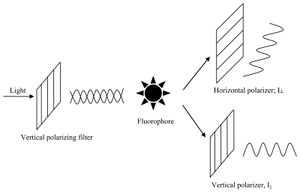Fluorescence polarization
HOWEVER HOW ABOUT EXPLAINING THE BASIC PRINCIPLE MORE CLEARLY? THE EQUATIONS ARE NOT CLEAR AT ALL.
Introduction[edit | edit source]
Fluorescence polarization (FP) is a homogeneous method that allows rapid and quantitative analysis of diverse molecular interactions and enzyme activities. Fluorescence polarization or fluorescence anisotropy (FP/FA) is a versatile solution-based technique that has been widely used to study molecular interactions, enzymatic activity, and nucleic acid hybridization. After its first theoretical description in 1926 by Perrin, the application has evolved from obtaining binding isotherms under carefully controlled settings to the study of small molecule-protein, antigen-antibody, and hormone-receptor binding in miniaturized automated settings. It was not until the mid 1990's that FP was adopted in high throughput screening to facilitate the drug discovery process, with its use being extended from direct interaction studies to complex enzymatic assays. In simpler words, the technique of fluorescence polarization (FP) is based on the observation that when a fluorescently labeled molecule is excited by polarized light, it emits light with a degree of polarization that is inversely proportional to the rate of molecular rotation.
Importance and medical relevance[edit | edit source]
Fluorescence polarization measurements have long been a valuable biophysical research tool for investigating processes such as membrane lipid mobility, myosin reorientation and protein–protein interactions at the molecular level. Immunoassays that have been developed and used extensively for clinical diagnostics represent the largest group of bioanalytical applications. This technique has been widely utilized in clinical and biomedical settings, including the diagnosis of certain diseases and monitoring therapeutic drug levels in body fluids. Recent developments in the field has been symbolized by the facile adoption of FP in high-throughput screening (HTS) and small molecule drug discovery of an increasing range of target classes.
Process[edit | edit source]
The principle of FP derives from the fact that the degree of polarization of a fluorophore is inversely related to its molecular rotation (Figure 1), itself being largely driven by Brownian motion. Quantitatively, FP/FA is defined as the difference of the emission light intensity parallel (I||) and perpendicular (I⊥) to the excitation light plane normalized by the total fluorescence emission intensity (Equation 1 and 2, FP and FA are used interchangeably.
FP= I||−I⊥/I||+I⊥
(Equation 1)
FA=I||−I⊥/I||+2I⊥
(Equation 2)
It can be seen from Equations 1 and 2 that the FP value is independent of fluorophore concentration as it is not dependent on the absolute intensities of the emission light collected at either orientation. Such an independence of FP on the concentration of the fluorophore reagent (within the limits of instrument linearity and sensitivity) has largely been observed in a very broad spectrum of experimental settings and FP assay formats, and deviation from this relationship can serve as an indicator of fluorescence probe aggregation (anomalous FP increase and premature fluorescence intensity saturation upon increase of fluorophore concentration).
Strengths and drawbacks[edit | edit source]
| Advantages | Disadvantages |
|---|---|
| Low limit of detection | Can suffer from autofluorescence |
| No need to separate bound vs. Unbound form of the receptor | Expensive Instrumentation |
| No radioactive waste is generated | |
| Insensitive to variation in probe concentrations |
Conclusion[edit | edit source]
Fluorescence Polarization will continue to facilitate clinical and therapeutic work in the years to come, where it is speculated that the use of multi-photon techniques that would revolutionize Fluorescence polarization as we know it.
References[edit | edit source]
http://www.ncbi.nlm.nih.gov/pmc/articles/PMC3277431/
Perrin F. Polarization of light of fluorescence, average life of molecules. J Phys Radium. 1926;7:390–401.


